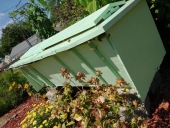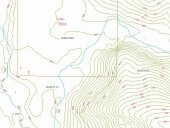posted 2 years ago
This will be more like a mental foraging walk, but hopefully it gives some good suggestions.
Ostrich fern is a very good suggestion, for vegetables early in spring. Ramps too, and honewort, though I haven’t tried them yet.
Along river beaches, I find black mustard, soapwort for soap substitute, reed-canary grass, (a lovely native species mislabeled as invasive, for crafts and compost,) watercress, wintercress (personally, bleh!!) as well as some dame’s Rocket (a very good vegetable, especially cooked, but considered invasive.)
That is in nutrient rich streams. Higher upstream I see wood nettle in great abundance, as well as skullcap occasionally, and lots of mushrooms, especially chanterelle and black trumpet where the habitat is right. I was recently told that matsutake appreciates moist hemlock forests too.
Currant also grows well near water. I took some cuttings from one variety this year from right above a little sandy creek, although I’m not sure whether they are black or red. In that same area I found stinging nettle, dogwood (I use them as toothbrushes,) cuckoo flower nearby (a bit invasive but tasty and very pretty), ostrich fern, I think there was some false Solomon’s seal (another good food plant), and lots of dame’s rocket.
Angelica, bugleweed, toothwort (spicy spring greens/roots) appreciate the moist soil. Perhaps spikenard (very tasty shoots and berries, medicinal roots) would like it, but they tend to prefer the sides of logging roads in moist soil. Certain grapes, Jerusalem artichoke in slightly sunnier spots, mint of course… Comfrey loves it there… butternut or walnut, if there’s enough sun and rich soil… red mulberry I would love to plant if I can find some…
Sochan is good as a cooked green. Canada lily, a picky plant with sweet starchy roots, rather slow growing. Chokecherry grows a bit above the floodplain—find a plant with good berries before propagating. Nannyberry, hobblebush berry are both good, the latter better tasting but maybe a bit out of your range, liking streamsides in higher altitude forests. Hazel. I can’t stand the smell of highbush cranberry, but maybe you can.
Trees can be good for tea: any conifer except yew, yellow birch. Black locust likes a bit more sun but good for firewood and edible flowers. Assuming a well-drained floodplain, I’ve seen red oak venture that low in the valley. Perhaps you will find multiflora rose, small sweet fruit but very invasive. Elderberry of course but I’ve never been able to gather much. Hackberry. Maple for tapping.
The one place where I have been doing intentional gardening is in sloughs, where I have grown tuber bulrush, soft stem bulrush, and calamus. The former two have edible roots in summer before they harden. There is also wapato growing wild, but the beavers always get to them before I do.

 7
7




 4
4




 5
5




 4
4




 5
5




 7
7




 4
4




 5
5





 5
5




 8
8




 6
6




 8
8




 3
3




 3
3




 4
4




 2
2




 4
4










